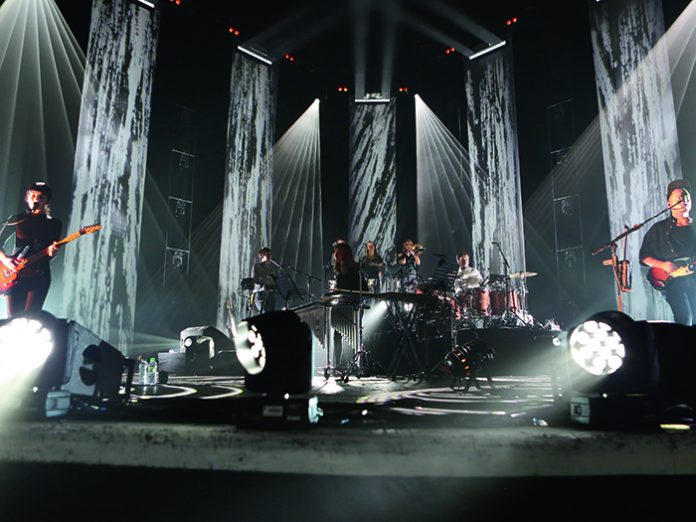I’m not entirely sure who coined the term neo folk rock, but it seems to fit well for London-based electronic trio, Daughter. Fronted by Briton Elena Tonra, alongside Swiss-born guitarist Igor Haefeli and French drummer Remi Aguilella, the band are developing a live show as enchanting as their ethereal sound. Kelly Murray speaks to the young crew helping Daughter deliver visual beauty and audio clarity on the road.
Having begun his relationship with the band six years ago, as FOH engineer and tour manager, Neil Dodd – who has since taken up the reins as FOH / PM – could often be found driving Daughter up and down the country the way most DIY-influenced bands start out, forming bonds that spawn a very personal and respectful way of working. “I was driving to every church they played in, in some very, very cold conditions!” he reminisced. “We love playing churches and older venues like that, because it’s often such a beautiful setting with a different vibe than those found in modern venues. The acoustics you get in churches meant we could use the reverb of rooms, which helped out with their sound a lot.”
Their sound is somewhat of a talking point; considering the modest budget the band has at this stage in their careers, their top class sound engineers have developed a technical feat that takes up little space yet delivers boldly. The band’s increasing popularity has ensured they’re now in demand at larger venues. This tour enjoyed a finale at Brixton Academy before venturing to the US, where its currently working its way through the theatre circuit.
Continued Dodd: “Over the years, it’s gone from being just us in a van, to developing a sound that requires an extra session musician, a brass and percussion section, and for the first time ever, a truck for our PA. “It’s quite intricate music. It’s detailed across the board with lighting and sound, so it’s a good challenge for all of us. To get that cross between a pop mix where the vocal is nice and loud, and also keep the ethereal nature of the music at the forefront is a hard balance to make, but we’re achieving it. Everything they do is played live so there is no backing track at all, just samples on the keys. I mean, every production manager is budget conscious and we could have saved ourselves a fortune by buying a hard drive and pressing play, but where’s the fun in that? There’d be more space on the bus for a start!” he laughed.
RENTAL RELIANCE
When it comes to his suppliers, Dodd knows what he wants in a vendor, and why those rental relationships are vital. “Because I came into a production role from an engineer’s background, I know what it’s like to work with suppliers that crew have an existing connection with. We’ve been using Adlib Audio since October 2015, and they’ve been cracking – the preparation of our gear is great, so we never have to worry about a single thing. All of their techs are really happy for you to plumb their knowledge and use them as a resource too, which is always a great bonus in a supplier. When you’re going into new venues, you can always rely on Adlib to sound them out and work out exactly how you want something done.
“As for lighting, I chose to use the supplier Sam [O’Riordan, LD] trusts. He’s got a long-standing relationship with TSL, and he’s been very happy with them.”
O’Riordan furthered: “I met Sam Tamplin, the director of TSL, a long time ago, when he started a small lighting company operated from his grandma’s garage and his dad’s front room! I used to tag along to events at weekends, and after a few years, his company really took off. “Every time I walk into that warehouse, it amazes me how much they’ve grown – it’s got a special place in my heart. I’ve watched it grow from being their first employee to it now employing over 40 people. In North America, we use Martin Kelley from Christie Lites, because they follow a similar ethos to TSL, in their immaculate prep, equipment and service.”
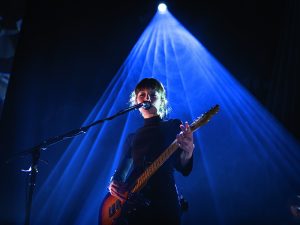
Dodd continued: “Our freighting company, EFM have also been brilliant; we did a run of crazy festivals going from Milan to Lithuania in a couple of days and they didn’t even break a sweat! They send a driver out and crack on – our gear always gets there and there’s no fuss whatsoever.”
Finishing the vendor jigsaw is Phoenix Bussing, which Dodd describes as being “very comfortable,” and, for the first time, trucking duties came courtesy of Fly By Nite.
In case you hadn’t gathered, the ambience on this tour is all very pleasant. We’re currently sat on sofas while an open conversation ensues, making it obvious I’m in the presence of zero egos and multiple friendships. Tour Manager Cameron Stewart described the crew as really tight, stating: “We’re honestly a happy little bunch. We all genuinely like each other, and we’re pretty decent people… you have to be when you live on a bus together.”
CREATIVE CONSOLES
Perhaps the glue to these friendships is the level of excitement and appreciation felt within their jobs; they light up with child-like excitement when discussing gear, and seem pretty happy to have ended up with touring careers. For both Dodd and Monitor Engineer Jamie Hickey, DiGiCo is their think pad, at FOH, Neil is using an SD11i. Monitor mixes benefit from a DiGiCo SD10 for the larger, more complex shows, and an SD11i for the regular touring schedule. Dodd’s SD11i currently has 52 inputs, eight FX, four Stereo Groups and four Mono outputs. He uses a Waves Extreme server for most of his dynamics and effects, using the on-board Dynamic EQs for a few select things.
Dodd commented: “For the European leg of the tour we dropped both of our consoles down to SD11i’s because when we go to the US, we have to downsize from a truck to a trailer. The addition of the wind ensemble for the UK shows necessitated the move to an SD10 at monitors.”
Hickey explained: “I’m already using every input and bus on the SD11i for the regular Daughter show. Adding 4 extra musicians and 16 extra inputs requires something with a bit more grunt! By using DiGiCo’s SD Convert software, I’m able to switch my SD11i show file over to an SD10, loop in the extra SD Mini Rack and simply add the new inputs and outputs to my existing show. My Waves Multirack session is fully compatible too, so once we get to the US, it’s an easy switch back to the SD11i.”
Dodd agreed: “The transition between using an SD10 and SD11i is actually really easy because the Stealth Core 2 engine software allows you to do so much in a small unit. That’s the thing about using DiGiCo, every time you come up against something and ask the question ‘can it do this?’, the answer is always ‘yes!’”

Hickey continued: “To aid the change of consoles we’re both using Pi Engineering X-Keys and an app called ControllerMate which allows us to add extra macro keys to the SD11i, using a simple 1in-1out MIDI interface. I’ve currently got 28 macro keys to play with instead of the built in eight. By adding these extra keys, it means work flow is as quick as on the bigger SD10.
“With DiGiCo, I find that it offers a very easy way of working – the desks have been well thought out so it feels easy and natural to mix on, and, of course, they sound great. I’m happy to try out new desks, but every time I’ve gone to use different ones, they never match the clarity and user friendly customisation of a DiGiCo. I think they’ve set the benchmark for digital consoles,” he added.
Having honed his skills over the years, there is no one better to understand the band’s FOH mix than Dodd, but what has been slightly more challenging is the right person to mix monitors, as he explained: “It’s not difficult to mix necessarily, it’s more that engineers will often try to layer a bit of rock ‘n’ roll style into it, but this music is so very subtle, it needs attention to detail, and Jamie has that in spades. He’s very talented at what he does, and since he came along, we’ve never looked back.”
Hickey has 52 input channels from stage, 16 wedge splits, 10 stereo FX returns, plus 12 channels of comms/talkback. For outputs, he has eight stereo IEM mixes for the band and ensemble, three wedge mixes, a P&D BC2, three stereo mixes for the techs and TM, and a stereo Matrix as a spare.
He said: “They want a full-on, immersive experience on stage. They want it record quality and that’s the benchmark – it needs to sound amazing from start to finish and with DPA, DiGiCo and Waves that’s all possible! I have a bunch of go-to Waves plugins that never fail to hit the mark: SSL G-Master Buss Compressor, C6 Multiband, H-Reverb and Vitamin are all used to great effect.”
AUDIO APPROVAL
Hickey and Dodd have put a lot of thought in to the microphone choices for the Daughter setup. Each of the three guitar cabs are stereo mic’d, using pairs of AKG 414XLS, AKG 414 Xlii and Audio-Technica 4040’s. There are DPA 4099’s on the toms, brass and percussion; DPA 2011’s on the snares, vibes and ride cymbal; and perhaps most importantly, no less than six DPA d:facto’s for vocals.
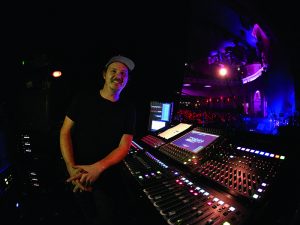
Dodd describes the d:facto as: “Totally game changing. We went over to Copenhagen to see their factory, and what they create there is nothing short of genius. There are parts that go into those microphones that are microscopic. Honestly, the components are so intricate, it blew my mind. Over the years I’ve gone through just about every vocal mic going to try and get the right kind of sound for Elena. As soon as we switched to DPA, we knew we’d found it.”
The band is all on IEMs, using Sennheiser SR300 G3 transmitters with Jerry Harvey Audio JH16’s and Rev33 Reds, the choice of Hickey’s. “If you’re going to be listening through something that sounds rubbish, there’s no point in having in-ears, is there? The detail in the top end is fantastic with JH Audio; I won’t use anything else.”
Hickey continued: “There was a moment in the show recently where the guitarist got on the talkback and was like “it sounds fucking brilliant!” and I thought “great!”, because when you spend so much time arranging all the little details such as panning, compression, reverb times etc, it’s great that someone that is so close to the music notices a change for the better.”
NO SETTLING
When required for the larger shows, Adlib supplied a PA and sound design (by Ian Nelson) who opted for a dual hang system. Two hangs per side consisting of two L-Acoustics K1 above six K2 which covered stalls and two hangs aside consisting of two K1-SB above six K2 flown above the balcony to cover the circle area. “Utilising the dual hang reduced slapback from the balcony, while the choice of K2 allowed for greater horizontal directivity and being able to use an 800KG point for an entire hang of PA including subs,” said Dodd.
ARCs were used for both in and out fill, and KARA lip fills were deployed to cover the downstage edge. “Having such a high gain on my vocal mic makes a zonal PA a must. The more control of boxes further away from the mic means that I can really add impact to the show without drastically affecting in-ear mixes, and keeping that vocal prominent in a loud mix. When you’re touring at this sort of level, there are so many variables. We do arena tours and whether you have to load in and out of a lift, if you’re angsty about it all it’s not going to work. It takes a bit of planning and organisation and a level head of thinking how everything is going to fit in,” he added.
“To work in our camp, you need to keep a level head, and a view of the bigger picture. This show is totally scalable going from one venue to the next, so everybody here is trying to look at the final result and realise that sometimes they might have to compromise. But I feel like with this set up, nobody settles for anything at the same time. It has to be close to perfect, no matter how we get there.”
FULL FUNCTIONALITY IN SMALL SPACES
LD O’Riordan came into the fold at the end of the last album campaign. “I’ve really enjoyed the challenge,” he smiled. “Because my background was in pop and rock and this was the first time I’d worked with folk and electronic music. You could say their sound is quite gentle, but there are tunes that are heavy too and that makes for an excellent dynamic when you’re designing lighting.
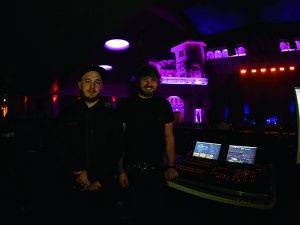
“Igor [Haefeli, guitarist] is a very creative guy, not just audibly, but visually too, so we worked on the look of the show together. The band is a three piece, predominantly, although we have the extra musicians on this UK run. When we were thinking about the design in terms of shapes, the most obvious for a three piece on stage for the majority of shows was a triangle. We quickly decided on a very clean look allowing for big open spaces, yet utilising and emphasising depth effectively. In doing this we flew five 1.5m wide grey sails, arranged in a ‘V’ formation, one sat centre and four at a 35° angle heading down stage. The original plan was to project onto these sails with video, but reflecting on cost, we quickly realised this wouldn’t be a viable option within our budgetary restraints.
“As an alternative option, we decided to use spot lights, with good old fashion theatre tricks – focussing between gobo and animation wheels – creating texture and movement, and using blades to shutter into the sail.
“We also had a mirror image of fixtures, from rig to floor. The full rig comprised five Martin by Harman MAC Viper Performances, four Martin by Harman MAC Viper Profiles, six Martin by Harman Aura XBs, nine Robe Robin 600 Spots, 54 Robe Robin 100 Beams, 14 SGM P-5’s, 14 GLP impression X4 Bar 20’s, 20 2-Cell generic molefays and four ShowTec Sunstrip Active DMX strips, all of which had to cater for the absence of video elements.
“When it became apparent that video wasn’t a feasible option, I immediately knew that I wanted to use the Vipers as a spot. For me, the spot is all about optics, and clarity is key. The Vipers have mastered it. I’ve used the Vipers for projecting on to the sails because when you don’t have projection tools but you still want texture, and animated texture at that, it’s perfect. In terms of upstage backlight spots, we’re using the Viper Profiles, which again for the same reasons, I love the optics and the clarity of the beam.” O’Riordan also utilised Robe 100 Beams. “They’re not the newest of fixtures, but they’re great – lightweight, tiny, and energy efficient. You can throw them around the stage and still have a really big look on a budget.”
“The XBs are excellent wash lights, they’ve got a great zoom, a great colour mixing palette. The two GLP X4’s deliver bold colours. I didn’t want something that we were going to rig and just light the sails, and this fixture has the ability to tilt and the zoom amazingly well. I first noticed it at a festival, and I couldn’t wait to be able to use it on this tour. I really like what GLP are doing in general at the moment, their X4 wash lights are a really good design,” he noted.
For control, O’Riordan uses his trusty MA Lighting setup; a grandMA OnPC Command Wing and a grandMA Fader Wing. “The great thing about this MA setup, is that I have the full functionality in terms of parameter count of an MA2 Light, with a tracking back-up, that fits into a 1610 Peli, I can fly it everywhere – pretty revolutionary!”
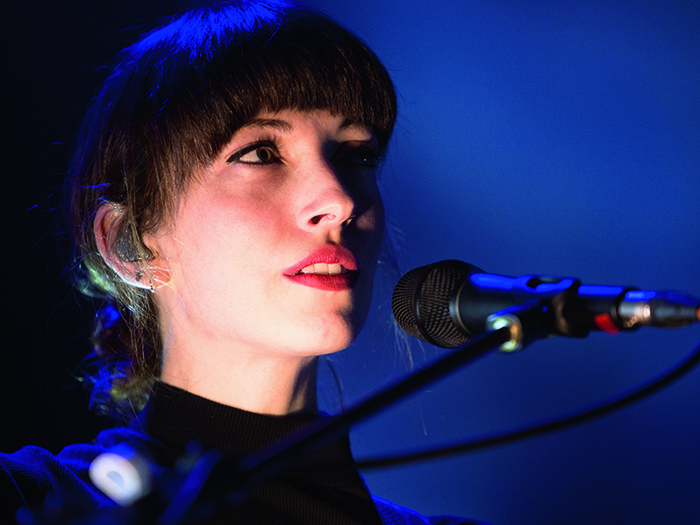
With the band’s finale taking place in their homebase of London, the show had to be spectacular. And O’Riordan relished the opportunity: “Brixton was a great show. The intricacy of their music makes this a really exciting tour to work on, yet a challenging show to light. There’s so much detail to pick out and highlight, even more challenging sometimes is to leave it alone and allow the music room to resonate with the audience without distraction. Yet framing a song with a visual representation, an environment in which to effectively deliver the message behind its origin is important. Elena, and the band are such beautiful songwriters, that less is so often more within a large portion of their set.
“I can’t take full credit for the complete design, as a lot of the concepts we worked through and developed backstage at festivals with a pen, a napkin and some Spinal Tap dimensions moments! I love that way of working, it’s organic and really enjoyable – some ideas literally had us crying with laughter – but that’s the beauty of a creative process. I think the day I say a design is entirely my own is the day I should consider a new career, because for me personally, that would be ego getting in the way of a process that’s best enjoyed with others.”
After watching the show, there’s no doubt of the talent on offer in camp Daughter, both on and off stage. “The set often feels like I’m walking around a gallery, with each song being a different canvas, captivating a different emotion. The unity between visual and audible creativity excites me,” O’Riordan said.
Drawn in delicately by the unorthodox and dark love songs, and enchanted by an otherworldly and ambient stage setting, the production shows a well thought-out glimpse of something bound to develop further with unique ideas and technical expertise. Dodd concluded: “We encourage and support each other’s ideas, and I think that’s why we can hang out together on our days off too, believe it or not! We spend 15 hours a day, seven days a week together and still want to go for a beer and talk absolute nonsense! When you have a trusting relationship with everybody you work with, that’s how you become a proper team.”
TPi
Photos: Marie Korner, Zuzanna Sosnowska, Josiah Van Dien, Jake Haseldine


